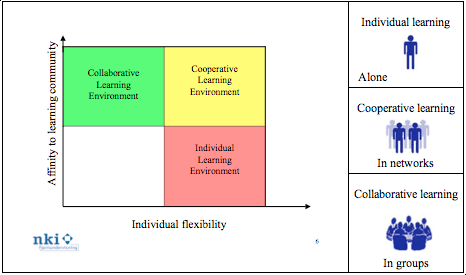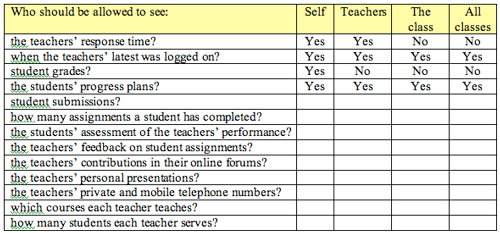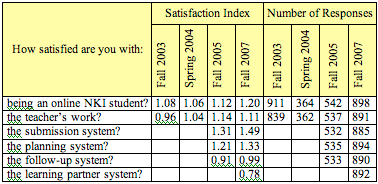Cooperative Online Education
(The cartoon used in Paulsen's presentation is also available here.)
Morten Flate Paulsen Professor, The Norwegian School of Information Technology (NITH)
E-mail:
mfp@nki.no
Abstract
Cooperative learning seeks to develop virtual learning environments that allow students to have optimal individual freedom within online learning communities. The pedagogical and administrative challenges with regard to accommodating both individual freedom and cooperation are explained in the Theory of Cooperative Freedom. This article shows that cooperative learning can be implemented successfully through a set of instruments or means. To illustrate this with current examples, the article presents NKI Distance Education’s surveys and experiences with cooperative learning. The article also discusses how issues such as web 2.0, transparency, learning partners and individual progression plans relate to cooperative online education.
Keywords: Online education, e-learning, cooperative learning, individual freedom, virtual learning environment, learning community, collaboration, flexibility.
Introduction
This article builds on the Theory of Cooperative Freedom. The first version of the theory was published in the monograph From Bulletin Boards to Electronic Universities (Paulsen 1992). It was updated in the book Online Education and Learning Management Systems (Paulsen 2003), and further versions with more examples are available in English (Paulsen 2006), Portuguese (2007) and Norwegian (Paulsen 2007). The theory is also presented at several international conferences where feedback from participants has contributed to refinement of the theory. It is based on three theoretical perspectives on distance education described by Keegan (1996, 56). The three perspectives are: autonomy and independence (e.g. Moore 1988), industrialization (e.g. Peters 1988), and interaction and communication (e.g. Holmberg 1988).
The article illustrates the Theory of Cooperative Freedom including recent feedback from international colleagues, current system developments and participatory observations at NKI Distance Education, as well as examples and surveys from NKI. Having about 14.000 students, NKI is Scandinavia’s largest provider of distance education and among the European Megaproviders of online education (Paulsen 2007). About two thirds of the students are enrolled in NKI’s more than 450 online courses. To handle this, NKI operates a self-developed LMS system named SESAM (Paulsen and Rekkedal 2003). It is developed to support cooperative freedom and transparency in a large-scale online education environment.
This article also presents results from four evaluations which included questions about NKI’s cooperative tools and services. They are documented in three internal reports (Paulsen 2005, 2006 and 2008). The first survey received about 910 responses, the second 360, the third 540 and the last 890 responses.
Cooperative Learning
Learning theories can be individual, collaborative or cooperative, and online education technology can support the theories. In a white paper from Epic Group plc on personalization and e-learning, (Clark 2004, p26) concludes that technology may support both individual learning and access to social networks. In the article Collaborative versus cooperative learning, Panitz (2003) starts to point out that there is a certain overlap and inter-concept usage between cooperative and collaborative learning and that it is an elusive goal to find a distinction between their definitions. In this theory, however, the three terms are clearly distinguished and defined as follows:
Individual learning provides superior individual flexibility, but very limited affinity to a learning community. It has a strong position in online education delivered by institutions with a tradition in distance education.
Collaborative learning requires participation in a learning community, but limits individual flexibility. One may say that collaborative learning requires that students sink or swim together. Collaborative learning is common in online education offered by traditional face-to-face institutions.
Cooperative learning focuses on opportunities to encourage both individual flexibility and affinity to a learning community. Cooperative learning seeks to foster some benefits from individual freedom and other benefits from cooperation in online learning communities. It thrives in virtual learning environments that emphasize individual freedom within online learning communities.
After some personal communication, Stephen Downes (2007) inferred in a blog entry that another way to distinguish between the three terms is to claim that individual learning is conducted alone, collaborative learning depends on groups and cooperative learning takes place in networks.
The differences between the three learning theories are illustrated in Figure 1.
Figure 1. Individual, cooperative and collaborative learning environments
Well-designed virtual cooperative learning environments build on a number of means that support individual flexibility and other means that facilitate affinity to a learning community. The Theory of Cooperative Freedom is based on the following three pillars:
1. Voluntary, but attractive participation
2. Means promoting individual flexibility
3. Means promoting affinity to learning community
Cooperative Learning is Voluntary and Attractive
A cornerstone in cooperative online education is that cooperation should be voluntary, but attractive and appealing. It should be offered as an appealing opportunity to those who seek cooperation. The challenge is therefore primarily to help those who are interested in cooperation to engage in a network of learners and learning resources. In addition it is necessary to stimulate the rest to contribute to the learning community. This means that students should not be encouraged or tempted to completely withdraw from the learning community. Total seclusion is not desirable. Students should be stimulated to be visible as potential partners and resources for others. Transparent information could be a huge cooperative resource. The dilemma is that students, who do not contribute to the community, cannot be perceived as learning resources for others. The potential of the learning community will then be diluted. So, one may argue that a successful cooperative learning community may depend on members who are committed to serve as resources for the learning community.
NKI’s Cooperative Philosophy for Online Learning
NKI has developed the following philosophy on cooperative online learning: NKI Distance Education facilitates individual freedom within a learning community in which online students serve as mutual resources without being dependent on each other.
Version 6 of SESAM, NKI’s learning management system, was developed in 2007 when there was much focus on web 2.0 services. Therefore, it was based on a systems development philosophy stating that the services should be personal, interactive, dynamic and transparent. They should further stimulate students and teachers to produce, share and refine content they all will benefit from.
Transparency Supports Cooperation
Transparency is important for cooperative online education. People can cooperate more easily if they know something about each other and have access to some common information and services. Cooperation will benefit when general and personal information related to the learning and the learners is available directly or indirectly to the learning community. This transparent information may include personal information about the users and statistics related to the users’ application of the online tools. It may further include work students and teachers provide in online notebooks, blogs and discussion forums as well as results derived from quizzes, surveys, and assignments.
Transparency implies that users to a certain extent gain insight and are visible, but it is important to find a suitable transparency level. The theory hypothesizes that transparency is an important driver for improved quality, and that it has the following three positive effects on quality:
- Preventive quality improvement; because we are prone to provide better quality when we know that others have access to the information and contributions we provide
- Constructive quality improvement; because we may learn from others when we have access to their data and contributions
- Reactive quality improvement; because we may receive feedback from others when they have access to our data and contributions
Transparency may reduce the amount of low quality contributions and make high quality work more accessible as paragons for others. In transparent learning environments, poor contributions from teachers and course designers cannot easily be hidden behind closed doors.
It is important to realize that transparency must be handled carefully with regard to privacy issues. The users must be confident that privacy is well taken care of. They should be able to choose their preferred privacy level and understand how this choice controls how much of their personal data and contributions that will be available to others. The challenge of finding the correct transparency level is illustrated in Figure 2.
Figure 2. Finding the right balance between transparency and privacy
A few examples of information that may be more or less transparent in online education are presented in Table 1. It is interesting to discuss the consequences of making the matrix items transparent to various user groups.
Table 1. Transparency matrix that could be used to discuss transparency levels
Information that is too personal to be transparent could still be very useful if it is presented as statistics or averages. Individual grades are usually only presented for the student and the teacher. However, it might be useful to make average course grades available for everyone.
Social Software and Web 2.0 Support Cooperative Learning
The Internet trends that are most interesting for online education today are related to social software and web 2.0. Some well-known examples are blog, wiki, RSS and social bookmarking. The most interesting characteristic of web 2.0 is the development of social networks and communities that are hugely successful since the users produce, share and refine information of mutual interest and benefit for all the community members. Some relevant examples are Wikipedia, YouTube, Flickr, Slideshare, Diigo and Facebook.
Some online educators argue that social software and online communities will conquer Learning Management Systems (LMS) as the predominant online learning environment. They argue that Personal Learning Environments (PLE) in which students pick and utilize various social software services and online communities are more flexible and develop faster than existing LMS systems. One may however argue that few students and teachers have enough competence and resources to set up PLEs themselves. At the same time, providers of online education need the structure and administrative tools available in LMS systems to handle large-scale online education cost-effectively. Therefore the challenge is to improve the LMS systems by adapting tools and services based on the philosophy and features in social software and online communities.
Cooperative Evaluation and Quality Barometers
Evaluation and quality control is crucial but challenging in large-scale online education based on individual progress plans. Some of the challenges are related to the following questions:
- When should it be done – once a year – near the end of the course - continuously?
- What should be evaluated if the aim is to improve quality?
- How should the results be presented, and how transparent should they be to have the best impact?
- How could evaluation be automated and managed with a reasonable workload?
In cooperative learning environments, the findings and results should be reasonably transparent, and relevant information should be available to the appropriate user groups so that they can learn from the results and understand that they are members of a larger learning community.
NKI developed an evaluation tool which was used for the first time in 2003. It has later been used in all NKI surveys referred to in this article. The system allows NKI to develop common forms of questionnaires and evaluation forms. Each form can be assigned to one or more user categories, e.g. teachers, students in one course or all students. A user may only respond once and all replies are anonymous. When a user responds, the evaluation database is updated and the user is granted access to a personal evaluation report. The transparent reports that are generated from the database vary according to the user category:
- Students may see a report showing qualitative statistics of interest to students in their course
- Teachers may see the same report as the students with additional teacher information. The teacher information could come from certain parts of the questionnaire or from comparative data in other courses.
- Administrative staff may see comparative reports showing responses from all user groups and questionnaires. This means for example that one can compare responses in all courses. This could for example be used to identify teachers who receive excellent evaluations or courses that receive worrying evaluations.
One weakness with the existing system is that it is not meant for continuous evaluation. Therefore, NKI has started integrating a new feature, termed quality barometer, which continuously records evaluation data and presents dynamic reports on important indicators of quality.
Means Promoting Individual Flexibility
In cooperative learning, individual flexibility and freedom is paramount. As illustrated in Figure 3, The Theory of Cooperative Freedom (Paulsen 2003) suggests that important flexibility facets are: time, space, pace, medium, access, and content.
In his article Distance learning – Social software’s killer ap? Terry Anderson suggests an additional facet:
I have suggested to Paulsen the need for a seventh freedom: that of freedom of relationship, where learners are allowed to engage in the type of learning relationship with other learners that best fits their individual social needs and capacities (Anderson 2005, 3).
The freedom of relationship is however so central to the theory that it is included in the middle of Figure 3. It illustrates that there is a tension between the urge for individual independence and the necessity to contribute in a cooperative learning community. It is therefore necessary to find a reasonable balance between individual flexibility and participation in the learning community.
Figure 3. Facets of flexibility discussed in the Theory of Cooperative Freedom 
In
Personalisation and e-learning, Clark (2004) discusses individual flexibility regarding: learning style, motivation, portfolios, where to learn, what to learn, when to learn and how to learn. He infers (Clark 2004, p6) that: “Many simply want a predictable system that works rather than a profusion of choices. Theorists may want to complicate things but simplicity is often a virtue in practice”.
It should also be emphasized that flexibility is not easy to provide. Individual flexibility tends to add costs, administrative difficulties and pedagogical challenges. In the book
Flexible Learning in a Digital World, Collis and Moonen (2001, 16) present several factors that constrain learning flexibility. They state that flexibility could be unmanageable, not acceptable, not affordable, and not realistic.
Individual Progress Plans
One of the most strategic decisions online education providers need to make is whether the students’ progress plans should be individual or collective. This is a decisive dilemma and challenge for cooperative learning, because its focus on individual flexibility favors individual progress plans while collective progress plans make cooperation easier.
It is possible to use various schemes for progress planning as illustrated in the following three models with varying degrees of enrollment flexibility:
- Traditional universities enroll students once a year.
- Some institutions enroll distance education students once per month.
- NKI enrolls students every day.
This article focuses on how cooperative learning is stimulated within NKI’s model, the only one of the three models that supports individual progress planning.
In learning environments with individual pacing, tools for individual progress planning could support planning and tracking of student progress. Such tools could provide various progress reports and opportunities to initiate automatic and manual reminders to procrastinating students. The tools could:
- Help students develop individual progress plans in courses and study programs
- Provide various progress reports allowing students, teachers and staff to detect procrastination and initiate a set of services to help students proceed
- Reduce dropout rates by improving support to and communication with procrastinating students
- Suggest potential learning partners based on the database of progress plans
As shown in Figure 4, NKI has integrated tools for individual progress planning in its LMS system SESAM. All students are encouraged to register their individual progress plans, and they may change their plans whenever they like.
Figure 4. NKI’s planning tools allow individual students to register submission dates for all course assignments by clicking the chosen assignment number and date in the pop-up calendar. 
One challenge regarding individual progress planning is to decide how voluntary or obligatory it should be. The more students using the planning system, the more useful it is for the community. As illustrated in Figure 5, the students’ contact list would be less useful if it only showed planning information for some of the students.
Figure 5. NKI’s contact list showing some progress plan information for fictitious students 
NKI introduced the planning system as a voluntary option in May 2004. In February 2005, about 2200 students had registered their plans. From October 2006 the number has been quite stabile around 3900. This is a large number, but it still constitutes less than 50% of the student population.
Three surveys (Paulsen 2005, 2006, 2008) answered by 154, 336 and 763 students, revealed that the respondents were very positive to the planning system. In the three surveys, 88%, 80% and 87% of the responses were either very satisfied or satisfied with it and only 1%, 3% and 2% were either dissatisfied or very dissatisfied. The remaining responses were either neutral or expressed no opinion. In the qualitative responses, the system was referred to as simple and motivating. Some stated that it made planning easier and resulted in improved progression. A typical comment was: It helps me keep up a steady study progression so that I finish the work before my exam.
Following-up Individual Progress Plans
In a cooperative virtual learning environment, following-up individual progress plans could be supported by the individual student, automated e-mail and SMS messages, tutors, administrators and cooperative students. The most interesting strategy is to allow students to receive information about other students’ progress plans, but some oppose transparency that allows others to view their plans. One may however argue that these students may be the ones that will benefit most from having more focus on their progress plans.
Since the Fall of 2004, NKI has gradually introduced, tested and evaluated its system for following-up individual progress plans. When students log on, they see the number of days to each of their planned submissions. If one or more submissions are overdue, the student is reminded. The teachers receive similar information for all their students when they log on. The example in Figure 6 illustrates the type of information the NKI follow-up system provides for teachers.
Figure 6. Planning system services presented at a teacher’s web page
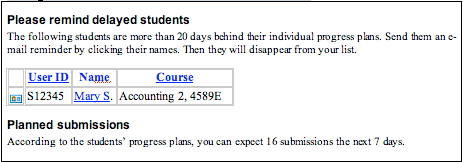
NKI is also testing, improving and contemplating good procedures to remind and encourage students who are delayed. The following means have been introduced:
- Standard e-mail reminders generated automatically and regularly by the LMS
- Tools that make it easy for teachers to send personal e-mail reminders to procrastinating students
- Tools that help administrative personnel send seasonal bulk reminders to procrastinating students
- Student access to catalogues that provide information about other students’ progress plans. This provides additional incentives for maintaining up-to-date progress plans. Some students may contact and encourage peers who have problems following their plans.
The reminders must be activated in a proper sequence and with adequate intervals so that students perceive them as personal and informative, not as irksome spam. It is also necessary to purge overly overdue plans so that the users perceive the plans as real. Plans that are more than 100 days delayed seem to be more annoying than useful. Further, there is a danger that the system unintentionally exposes dropouts to public contempt.
In his master thesis, Fagerberg (2005) interviewed 15 psychology students about their evaluation of NKI’s online tools. He (Fagerberg 2005, 4) concluded that systems and tools for planning and following-up were perceived as more important than tools for collaboration and social interaction.
Two surveys (Paulsen 2006, Paulsen 2008) answered by 336 and 763 NKI students revealed that the respondents were positive to the follow-up system. In the surveys, 66% and 71% of the responses were very satisfied or satisfied, 4% and 4% were dissatisfied or very dissatisfied. The remaining responses were either neutral or expressed no opinion.
Asynchronous Communication Supports Flexibility in Time
Asynchronous communication offers much individual flexibility in time, while synchronous communication makes students dependent on each other. E-mail and discussion forums are examples of asynchronous communication. Chat, videoconferences, telephone conferences, and face-to-face classes are examples of synchronous communication.
Because of its flexibility in time, asynchronous communication is the preferred form of communication in cooperative learning environments. Synchronous communication could however contribute to students’ sense of belonging to a learning community. Therefore synchronous communication could be a voluntary option, but obligatory synchronous communication should be avoided if possible.
Discussion forums are excellent means to promote cooperative learning communities. Students and teachers should be encouraged to use the forums instead of sending e-mail whenever others could benefit from reading the messages. The forums are usually organized and structured in topics or threads. As the number of contributions grows, the structure often becomes unwieldy and disorganized. When students have individual progress plans, it is even harder to organize and maintain a suitable structure. So, the users should be able to easily find new contributions and to sort the contributions by topic, date, and contributor to make it easier to follow the appropriate contributions.
When using individual progress plans, it is especially important to stick to a structure that clearly channels the contributions to the appropriate sections or study unit. If so, students can more easily find the contributions that are relevant for them. To support this, the administrators of NKI’s about 350 forums usually structure them with one section per study unit. These are fixed sections that cannot be altered by students.
Submission System
NKI’s submission system was initially developed to track and supervise the time from students’ submissions to teachers’ grading. It automatically records the time of submission and the time of grading.
By channeling both submissions and registration of grades through web-interfaces, the LMS system can provide features and reports related to:
- following-up the individual progression plans
- response time between submissions and registration of grades
Since the submission system also files all student submissions and teacher responses, it provides ample opportunities to develop cooperative services that allow the owners to give other students or teachers access to them. This can for example be developed further to include functionality for cooperative portfolio evaluation and for submission of cooperative papers.
Quality Barometer for Teacher Response Time
Three NKI surveys (Paulsen 2005, 2006 and 2008) maintain that swift response time is essential for student satisfaction and perception of a tutor’s work. In cooperative learning environments with individual progress plans and many courses, it could be wise but difficult to continually supervise response times for all teachers. This is a controversial issue, since some teachers may resist the idea of being supervised this way.
NKI has handled this by integrating a response barometer in the LMS system that records the time from a student submits a paper to the teacher registers the corresponding grade. The system allows NKI to provide the information at the teachers’ web page shown in Figure 7.
Figure 7. Response barometer that presents current response statistics at the teachers’ web-page
| NKIs response aim: 2 days. My average last 90/180 days: 1/1 days. Overall average last 90/180 days: 2/3 days. |
The response barometer was introduced in May 2004 and it resulted in much discussion in the teachers’ online forum. A few teachers voiced strong criticism, doubts and reservations. Others suggested improvements. Initially, the system showed average response times with two decimal points. This was not a wise choice because we never intended such detailed supervision and because the system was not accurate enough to provide correct decimals. Several teachers claimed that the statistics showed an average response time that was a fraction too high. However, it was interesting to observe that among the 150 teachers, the overall average response time accumulated over the last six months dropped month by month during the Fall of 2004. In October it showed 3.97 days, in November 3.06 days and in December 2.76 days. Since then, the overall average response time has been between two or three days, except from the summer holidays.
A few teachers still have an unacceptable long response time, so in April 2008 NKI introduced an automated e-mail message to teachers who had not registered a grade after seven days.
Means Promoting Affinity to Learning Communities
There are a number of means that could be used to strengthen affinity to virtual learning communities. Transparency and web 2.0 related services are central to these means. It is paramount that the participants are visible and accessible. In addition, the community members must be urged and stimulated to contribute to the community and to benefit from it. In the following some of these means are discussed.
Cooperative Student Catalogues Comprising All Courses
Student catalogues are important tools for showing students that they have access to a learning community. A comprehensive catalogue providing much relevant information about many students is crucial for the learning community. Student catalogues usually provide information about all students enrolled in a course. However, if students also can access information about students enrolled in other courses, they may benefit from taking part in a larger learning community. A catalogue that even includes alumni students could be of interest for students who seek advice on courses they consider enrolling in or on future employment.
To facilitate cooperation, the student catalogue should include information that makes it easy to initiate and maintain communication. This may be e-mail addresses, telephone numbers, chatting identities etc. that could facilitate electronic communication. It may also include postal codes that could make it easier to identify potential partners for face-to-face meetings. Similarly, it may include progress plan information so that students may identify peers who are working with the same study unit as they are. Finally, one may argue that student catalogues should include CV-type information to make it possible to search for peers with special competencies.
Student catalogues must handle privacy issues properly. Some information may be regarded as sensitive and require student consent to be included. Some students may also oppose inclusion in a student catalogue. The challenge is therefore to find the balance between providing as much relevant information as possible to stimulate cooperation without trespassing on students’ privacy thresholds. A viable solution is to ask students for permission to make the information available for the staff, the student enrolled in the actual course, or all students in all courses.
Cooperative Learner Profiles
The acronym CLIP – Cooperative Learner Information Profile has evolved as a result of the author’s deliberations on effective cooperative student catalogues. Using CLIPs, LMS systems may help students find learning partners (study-buddies) that are motivated and fitting for cooperation. CLIPs could herald a new and innovative pedagogy for cooperative learning. CLIP could provide efficient tools for establishing smaller and larger networks with the right mix of students. It could be used to establish contact between junior students and more experienced students who are willing to function as mentors. It could also be used to establish small colloquial networks based on geographic proximity or compatible progress plans. These networks could result in reduced dropout rates and better learning.
Based on CLIP and algorithms for teaming students, the system should suggest partners that have CLIPs that make cooperation interesting. Elements from NKI’s implementation of CLIPs are illustrated in Figure 8 and Figure 9. The students should have access to enough information to establish contact and tools to maintain cooperation. However, to develop suitable algorithms for this is probably not a trivial task.
Figure 8. An element from the students’ user interface
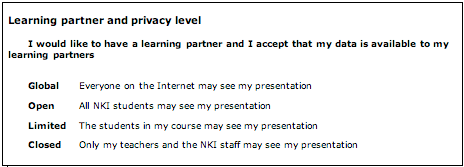
Figure 9. Illustration of the author’s personal presentation in NKI’s LMS system
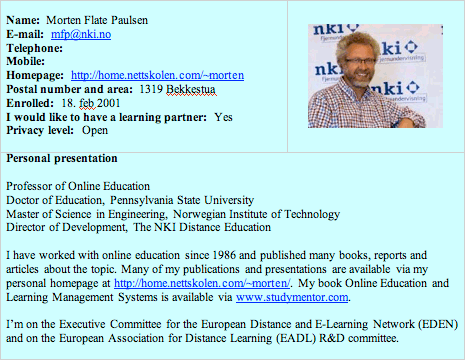
CLIPs may build on theories, ideas and features discussed in social capital and social software literature. Resnick (2002, p1) argues that socio technical capital is a new construct that provides a framework for generating and evaluating technology-mediated social relations. In online education one may think of this as learning capital. In a blog entry, Butterfield (2003) characterizes social software as tools that people use to interact with other people, employing information about identity, presence, relationships, conversations and groups.
Even though FaceBook, one of the very most successful social software services, was developed as a network service for students, social software applied for organized educational purposes at an institutional level seems to be scarce. In Norway, the University of Tromsø has introduced a social software service (www.hvaskjer.no) to enroll more students from secondary schools, and the Norwegian School of Management has introduced an online alumni service. In its alumni magazine, the school (2005, 92) states that 9000 alumni students have made use of the service. All alumni students have online contact cards that they may update and supplement with information about their work and professional interest. All alumni students may search the complete database of information in order to find useful resources and contact people.
An online survey (Paulsen 2005) answered by 154 NKI students showed that the majority wanted closer cooperation with one or more students. As many as 64 percent stated that they probably or definitively wanted closer cooperation. Only 16 percent responded that they probably or definitively did not want closer cooperation. The verbal comments also showed that many respondents wanted cooperation. Relatively many stated that they needed, wanted or missed cooperation and study-buddies. Some pointed out that it was difficult to contact other students; others wanted better tools to find partners. On the other hand, there were some respondents who stated that they didn’t need cooperation. They thought cooperation should be voluntary and stated that they preferred to study without being dependant on others. The survey also showed that 71 percent of the respondents were positive or very positive to seeing each other’s progress plans. Similarly 76 percent were positive or very positive to getting access to each other’s zip codes.
Online teachers could also benefit from finding partners for cooperation. Therefore, NKI provides teachers with a discussion forum and dynamic information that lists contact information for all 200 teachers and the courses they teach.
Learning Partners
Based on the learning profile concept and a student survey (Paulsen 2005), NKI introduced a service for Learning Partners (Slåtto and Paulsen 2006) in March 2006. The students who want Learning Partners are asked to:
- Register their personal presentations
- Decide who may access it
- Search for potential learning partners
- Invite somebody to become their learning partner
In November 2006, 3100 students had registered a personal presentation and an increasing number includes a personal picture. At the same time, 2500 had indicated their privacy level and preference regarding having learning partners. About 450 of the students had found one or more learning partners.In December 2007, 3900 students had registered a personal presentation. At the same time, 3689 had indicated their privacy level and preference regarding having learning partners as indicated in Table 2. About 750 of the students had found one or more learning partners.
Table 2. Student preferences regarding learning partners and privacy

The first major survey (Paulsen 2008) including a question about the learning partner services was answered by 763 NKI students. The results showed that 54 % of the responses were very satisfied or satisfied, 2 % were dissatisfied or very dissatisfied. The remaining responses were either neutral or expressed no opinion. The report concludes that the service has a potential to be developed further, and that the students need more time to get familiar with the services.
Cooperative Assignments
Assignments are crucial means to support learning theories. They should consist of tasks and directions. An assignment focusing on one task can easily support individual, cooperative or collaborative learning by varying the assignment directions. This is illustrated in the following example:
Assignment task: Explain the differences between individual learning, cooperative learning and collaborative learning.
Alternative assignment directions:
- Individual learning direction: Send your submission to your teacher.
- Cooperative learning direction: Discuss the assignment with a colleague or a peer student in your network. Write a short summary of the discussion and send it to your teacher.
- Collaborative learning direction: Write a paper in a group with one or two other students and submit it to your teacher.
Cooperative Assessment
Online assessment could be grouped in four categories (Paulsen 2003, page 68): self-assessment, computer assessment, tutor assessment and peer assessment. All categories could have a cooperative flavor if they are designed with transparency and cooperation in mind:
- Computer based assessment could have a cooperative flavor if students have access to statistics, results or information derived from all or some other students taking the tests.
- Self-assessment could be cooperative if students are encouraged to exchange self-assessments or may access some statistics or information from other students who have completed self-assessments.
- Peer assessment is cooperative if students are encouraged to voluntarily assess each other’s work.
- Teacher assessment could be cooperative if the students have access to some information the tutor provides or derives from assessing other students.
Portfolio assessment could support cooperative learning if the system allows students to access and comment on each other’s portfolios.
Cooperative Gating (COG)
Wells (1992) described gating as a pacing technique that denies students access to information before they have completed all prerequisite assignments. The acronym COG – Cooperative Gating – has evolved as an NKI term. It signals that students must complete a task to get access to a cooperative resource. This could for example be used as a stimulus for motivating students to answer in-text questions. They are allowed to see what others have answered only if they provide an answer others may read.
Conclusion
The evaluation tool developed by NKI was used in all four surveys referred to in this article. All four were designed to improve the quality of NKI’s online education. Several of the questions were included to evaluate and refine the cooperative tools developed by NKI. There were between 360 and 910 responses to the four surveys. So, the answers came from a substantial number of students. However, each survey represented less than 10 percent of NKI’s online students. Each survey was open to all students for approximately two months, but one may question whether the students who chose to answer were representative of the student population.
The most recent survey was conducted at the end of 2007. There were 763 students who answered the questionnaire which included nine quantitative and ten qualitative questions. Students who were enrolled in more than one course could respond one time per course, so there was altogether close to 900 responses. The results are available in an internal NKI report (Paulsen 2008) and the main conclusion states that NKI can be very satisfied with the results. The responses provide much information about how the students perceive the tools NKI has developed to support cooperative learning, and an overview of the responses to the relevant quantitative questions is provided in Table 3.
Table 3. Summary of responses related to NKI’s cooperative online education 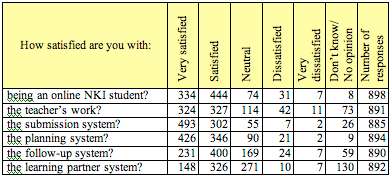
As shown in Table 4, some of the questions have been repeated in several of the surveys. The satisfaction indexes show positive trends which indicate that NKI’s incremental development of cooperative tools and services has been well received by the respondents.
Table 4. Summary of responses in the four surveys
The satisfaction index ranges from -2=very dissatisfied to +2=very satisfied
The results from the surveys indicate that NKI’s focus on a cooperative learning philosophy and incremental development of cooperative tools and services has been received positively by the respondents.
Author Biography
Morten Flate Paulsen is Professor of Online Education at NITH and Director of Development at NKI Distance Education (www.nki.no) in Norway. He is on the Executive Committee for the European Distance and E-Learning Network (EDEN) and on the European Association for Distance Learning (EADL) R&D committee. He has worked with online education since he designed NKI’s first Learning Management System in 1986 and published many books, reports and articles about the topic. Many of his publications and presentations are available at his personal homepage at http://home.nettskolen.com/~morten/. His book Online Education and Learning Management Systems is available via www.studymentor.com.
References
Anderson, T. (2005).
Distance learning – Social software’s killer ap? Retrieved April 29, 2008 from
www.unisa.edu.au/odlaaconference/PPDF2s/13%20odlaa%20-%20Anderson.pdf BI, (2005). BI Alumni – din arena for nettverksbygging. In
BI Magasinet, June 2005.
Butterfield, S. (2003).
Blog entry retrieved July 14, 2005 from
www.sylloge.com/personal/2003_03_01_s.html#91273866 Clark, D. (2004).
Personalisation and e-learning. Brighton, UK: Epic Group plc.
Collis, B. & Moonen, J. (2001).
Flexible learning in a digital world. London: Kogan Page.
Downes, S. (2007).
Blog entry. Stephen’s Web. Retrieved April 29, 2008 from (
www.downes.ca/cgi-bin/page.cgi?post=40001&format=html)
Fagerberg, T. (2005).
Fjernstudenters vurdering av nettbaserte pedagogiske tjenester. Master Thesis. København: Danmarks Pædagogiske Universitet.
Holmberg, B. (1988). Guided didactic conversation in distance education. In
Distance Education: International Perspectives, eds. D. Sewart, D. Keegan, and B. Holmberg, 114-22. London/New York: Croom Helm/St. Martins Press.
Keegan, D. (1996).
Foundations of Distance Education. Third Edition. London: Routledge.
Moore, M. G. (1983). On a theory of independent study. In
Distance Education: International Perspectives, eds. D. Sewart, D. Keegan, and B. Holmberg, 68-94. London/New York: Croom Helm/St. Martin’s Press.
Panitz, T. (2003):
Collaborative versus cooperative learning – a comparison of the two concepts which will help us understand the underlying nature of the interactive learning. Retrieved July 15, 2005 from
http://home.capecod.net/~tpanitz/tedsarticles/coopdefinition.htm Paulsen, M. F. et al. (2008).
Resultater fra spørreundersøkelsen blant nettstudentene ved NKI Fjernundervisning høsten 2007. Internal report. Oslo: NKI.
Paulsen, M. F. (Ed) (2007).
Megaproviders of e-learning in Europe. Bekkestua: NKI Forlaget.
Paulsen, M. F. (2007).
Kooperativ frihet som ledestjerne i nettbasert utdanning. Bekkestua: NKI Forlaget.
Paulsen, M. F. (2007). Cogs, clips e outros instrumentos de apoio à aprendizagem cooperativa realizada em ambientes virtuais. In Almeida, B. et al (Eds).
Livro de actas encontro de educacao em fisca do ensino basico ao supirior no sec. XXI.
Paulsen, M. F. (2006). Cogs, clips and other instruments to support cooperative learning in virtual learning environments. In Bernath, U and A. Sangrà (Eds.)
Research on competence development in online distance education and e-learning – Selected papers from the 4th EDEN research workshop in Castelldefels/Spain, October 25 -28, 2006.
Paulsen, M. F. (2006).
Resultater fra spørreundersøkelsen blant nettstudentene ved NKI Fjernundervisning høsten 2005. Internal report. Oslo: NKI.
Paulsen, M. F. (2005).
Resultater fra spørreundersøkelsen om NKI Fjernundervisnings planleggings- og oppfølgingssystem. Internal report. Oslo: NKI.
Paulsen, M. F. (2003).
Online Education and Learning Management Systems. Global E-learning in a Scandinavian Perspective. Oslo: NKI Forlaget. Retrieved July 18, 2005 from
www.studymentor.com/ Paulsen, M. F. (1992).
From Bulletin Boards to Electronic Universities: Distance Education, Computer-mediated Communication, and Online Education. 1992. University Park, Pennsylvania: The American Center for the Study of Distance Education.
Paulsen, M. F. and T. Rekkedal, (2003). NKI Fjernundervisning: Two Decades of Online Sustainability. In Paulsen, M. F. 2003.
Online Education and Learning Management Systems. Global E-learning in a Scandinavian Perspective. Oslo: NKI Forlaget. Retrieved July 18, 2005 from
www.studymentor.com/studymentor/NKI.pdf Peters, O. (1988). Distance teaching and industrial production: A comparative interpretation in outline. In
Distance Education: International Perspectives, eds. D. Sewart, D. Keegan, and B. Holmberg, 95-111. London/New York: Croom Helm/St. Martin’s Press.
Resnick, P. (2002). Beyond Bowling Together: Socio Technical Capital. In J. Carroll (Ed.),
Human Computer Interaction in the New Millenium. (pp. 247-272). Addison-Wesley. Retrieved July 18, 2005 from
www.si.umich.edu/%7Epresnick/papers/stk/ResnickSTK.pdf.
Slåtto, T. and M. F. Paulsen, (2006).
Learning partner - opportunities for cooperation in distance learning. Retrieved November 14, 2006 from
www.elearningeuropa.info/index.php?page=doc&doc_id=8294&doclng=6&menuzone=2 Wells, R. (1992).
Computer-Mediated Communication for Distance Education: An International Review of Design, Teaching, and Institutional Issues. University Park: The American Center for the Study of Distance Education.
